Community Teaching Plan Work Plan Proposal on Diabetes Prevention
VerifiedAdded on 2022/09/09
|8
|1469
|26
Project
AI Summary
This project is a comprehensive community teaching plan proposal designed to educate a target aggregate (ages 17-70) on the risks and prevention of type 2 diabetes. The plan includes an epidemiological rationale highlighting the prevalence of diabetes in America, a nursing diagnosis focusing on imbalanced nutrition, and an assessment of the target group's readiness for learning. It utilizes the "Teach-Back Theory" to enhance understanding and retention. The behavioral objectives are detailed, encompassing cognitive, psychomotor, and affective domains, with specific strategies for achieving them. The plan aligns with Healthy People 2020 objectives and incorporates interactive methods, such as food group presentations, to promote healthy choices and lifestyle changes. Evaluation methods, including post-session questionnaires and follow-up assessments, are outlined to gauge the plan's effectiveness. The proposal also addresses potential barriers and communication strategies to ensure successful implementation. The provided references support the plan's evidence-based approach.
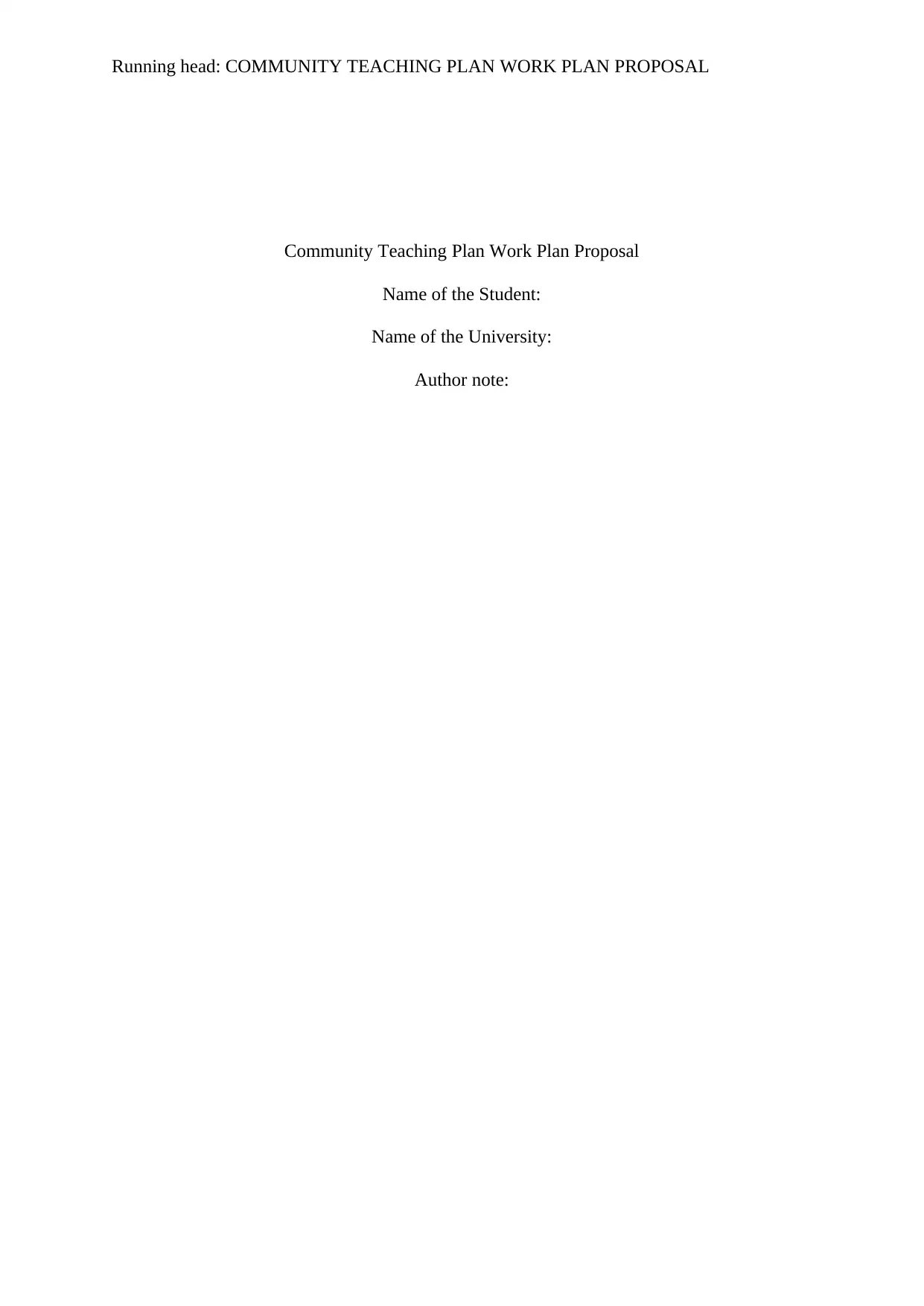
Running head: COMMUNITY TEACHING PLAN WORK PLAN PROPOSAL
Community Teaching Plan Work Plan Proposal
Name of the Student:
Name of the University:
Author note:
Community Teaching Plan Work Plan Proposal
Name of the Student:
Name of the University:
Author note:
Paraphrase This Document
Need a fresh take? Get an instant paraphrase of this document with our AI Paraphraser
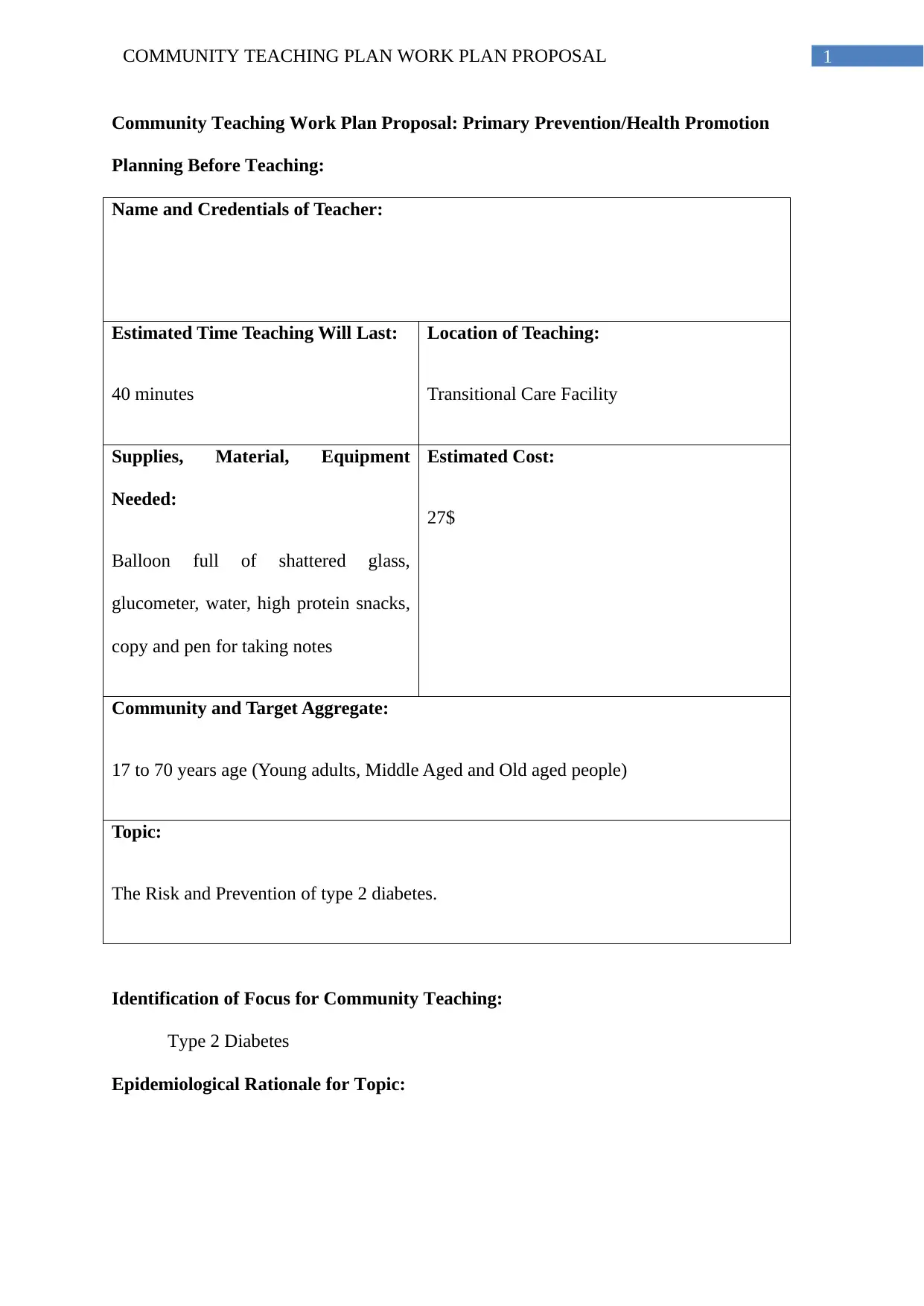
1COMMUNITY TEACHING PLAN WORK PLAN PROPOSAL
Community Teaching Work Plan Proposal: Primary Prevention/Health Promotion
Planning Before Teaching:
Name and Credentials of Teacher:
Estimated Time Teaching Will Last:
40 minutes
Location of Teaching:
Transitional Care Facility
Supplies, Material, Equipment
Needed:
Balloon full of shattered glass,
glucometer, water, high protein snacks,
copy and pen for taking notes
Estimated Cost:
27$
Community and Target Aggregate:
17 to 70 years age (Young adults, Middle Aged and Old aged people)
Topic:
The Risk and Prevention of type 2 diabetes.
Identification of Focus for Community Teaching:
Type 2 Diabetes
Epidemiological Rationale for Topic:
Community Teaching Work Plan Proposal: Primary Prevention/Health Promotion
Planning Before Teaching:
Name and Credentials of Teacher:
Estimated Time Teaching Will Last:
40 minutes
Location of Teaching:
Transitional Care Facility
Supplies, Material, Equipment
Needed:
Balloon full of shattered glass,
glucometer, water, high protein snacks,
copy and pen for taking notes
Estimated Cost:
27$
Community and Target Aggregate:
17 to 70 years age (Young adults, Middle Aged and Old aged people)
Topic:
The Risk and Prevention of type 2 diabetes.
Identification of Focus for Community Teaching:
Type 2 Diabetes
Epidemiological Rationale for Topic:
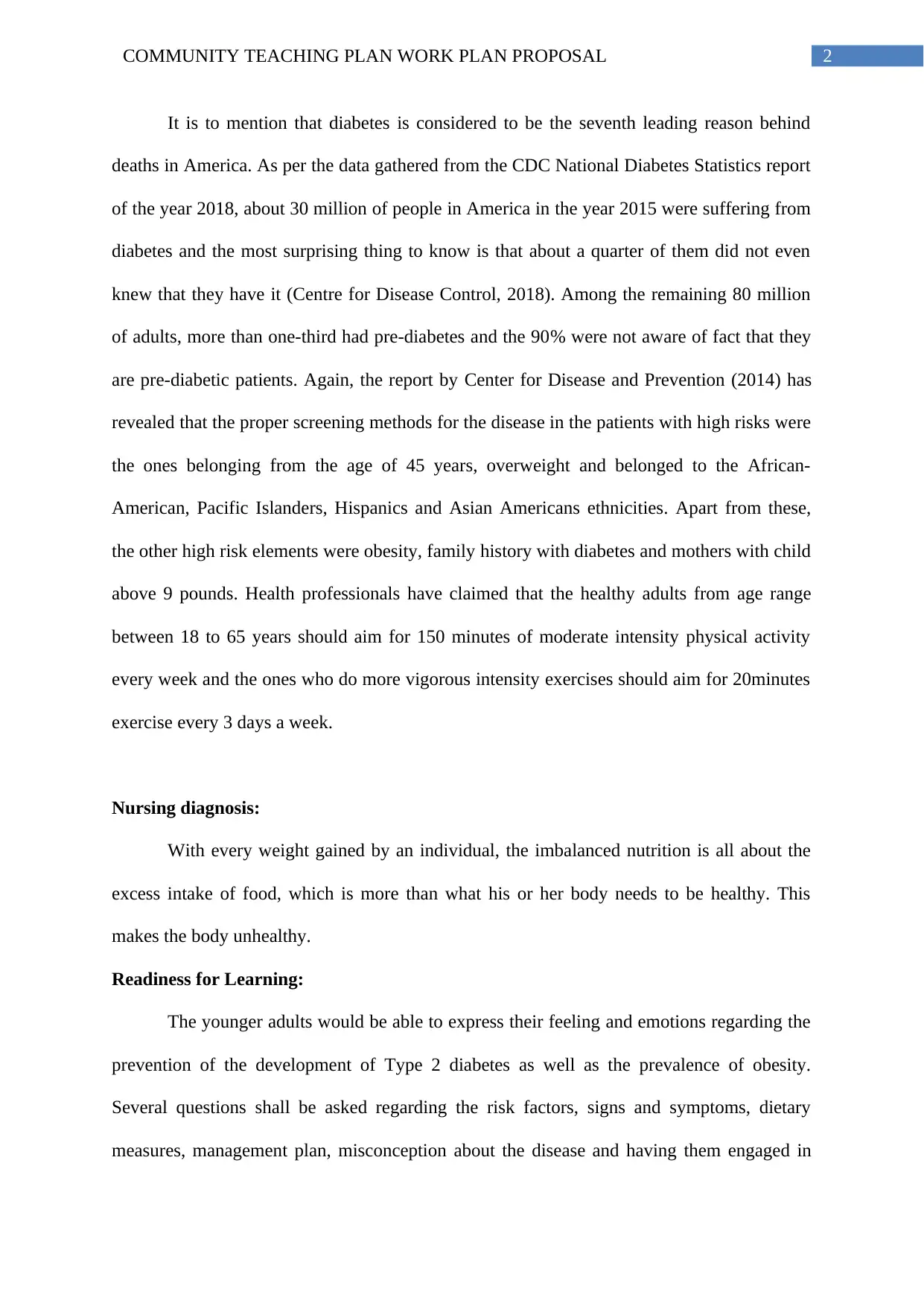
2COMMUNITY TEACHING PLAN WORK PLAN PROPOSAL
It is to mention that diabetes is considered to be the seventh leading reason behind
deaths in America. As per the data gathered from the CDC National Diabetes Statistics report
of the year 2018, about 30 million of people in America in the year 2015 were suffering from
diabetes and the most surprising thing to know is that about a quarter of them did not even
knew that they have it (Centre for Disease Control, 2018). Among the remaining 80 million
of adults, more than one-third had pre-diabetes and the 90% were not aware of fact that they
are pre-diabetic patients. Again, the report by Center for Disease and Prevention (2014) has
revealed that the proper screening methods for the disease in the patients with high risks were
the ones belonging from the age of 45 years, overweight and belonged to the African-
American, Pacific Islanders, Hispanics and Asian Americans ethnicities. Apart from these,
the other high risk elements were obesity, family history with diabetes and mothers with child
above 9 pounds. Health professionals have claimed that the healthy adults from age range
between 18 to 65 years should aim for 150 minutes of moderate intensity physical activity
every week and the ones who do more vigorous intensity exercises should aim for 20minutes
exercise every 3 days a week.
Nursing diagnosis:
With every weight gained by an individual, the imbalanced nutrition is all about the
excess intake of food, which is more than what his or her body needs to be healthy. This
makes the body unhealthy.
Readiness for Learning:
The younger adults would be able to express their feeling and emotions regarding the
prevention of the development of Type 2 diabetes as well as the prevalence of obesity.
Several questions shall be asked regarding the risk factors, signs and symptoms, dietary
measures, management plan, misconception about the disease and having them engaged in
It is to mention that diabetes is considered to be the seventh leading reason behind
deaths in America. As per the data gathered from the CDC National Diabetes Statistics report
of the year 2018, about 30 million of people in America in the year 2015 were suffering from
diabetes and the most surprising thing to know is that about a quarter of them did not even
knew that they have it (Centre for Disease Control, 2018). Among the remaining 80 million
of adults, more than one-third had pre-diabetes and the 90% were not aware of fact that they
are pre-diabetic patients. Again, the report by Center for Disease and Prevention (2014) has
revealed that the proper screening methods for the disease in the patients with high risks were
the ones belonging from the age of 45 years, overweight and belonged to the African-
American, Pacific Islanders, Hispanics and Asian Americans ethnicities. Apart from these,
the other high risk elements were obesity, family history with diabetes and mothers with child
above 9 pounds. Health professionals have claimed that the healthy adults from age range
between 18 to 65 years should aim for 150 minutes of moderate intensity physical activity
every week and the ones who do more vigorous intensity exercises should aim for 20minutes
exercise every 3 days a week.
Nursing diagnosis:
With every weight gained by an individual, the imbalanced nutrition is all about the
excess intake of food, which is more than what his or her body needs to be healthy. This
makes the body unhealthy.
Readiness for Learning:
The younger adults would be able to express their feeling and emotions regarding the
prevention of the development of Type 2 diabetes as well as the prevalence of obesity.
Several questions shall be asked regarding the risk factors, signs and symptoms, dietary
measures, management plan, misconception about the disease and having them engaged in
⊘ This is a preview!⊘
Do you want full access?
Subscribe today to unlock all pages.

Trusted by 1+ million students worldwide
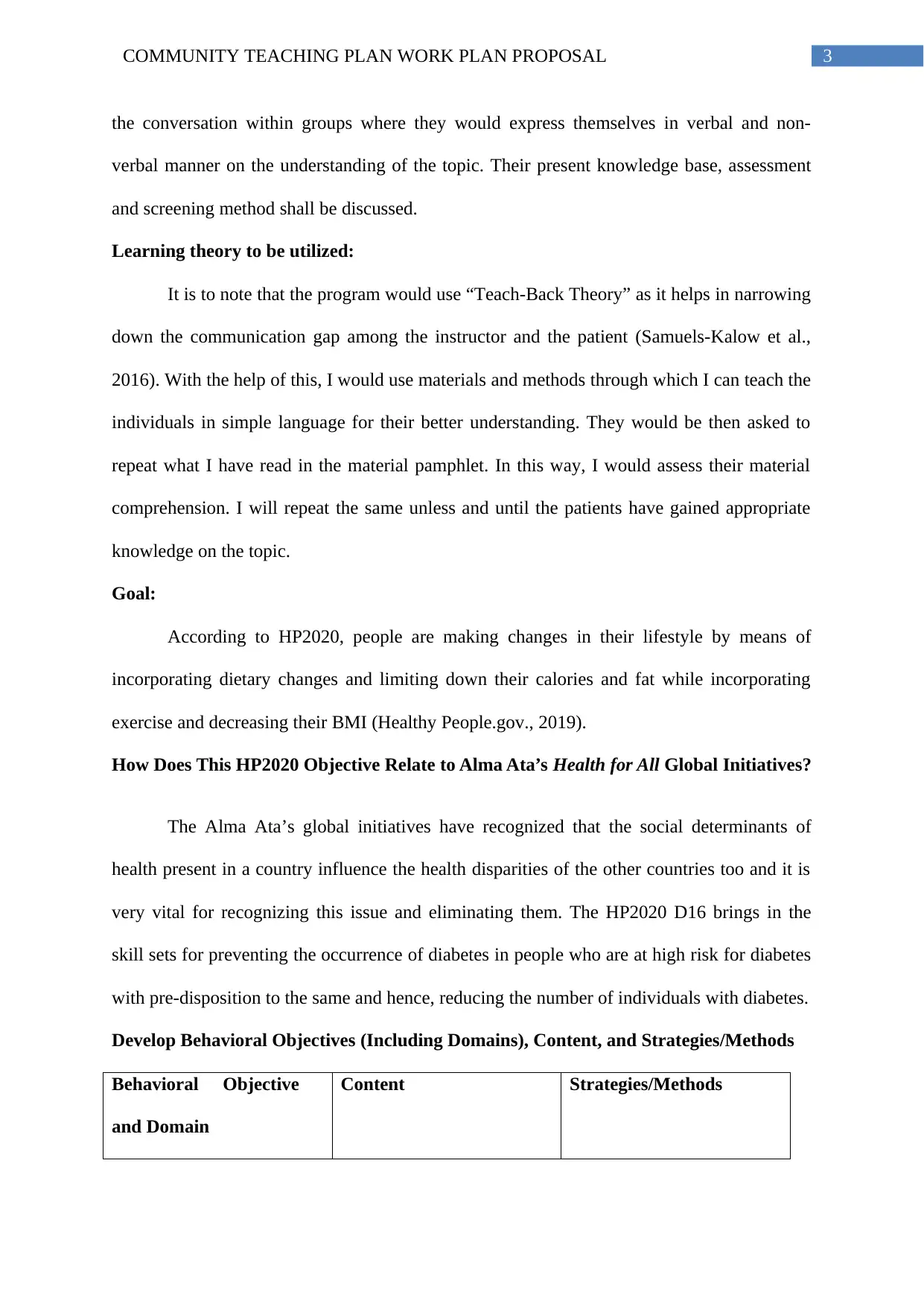
3COMMUNITY TEACHING PLAN WORK PLAN PROPOSAL
the conversation within groups where they would express themselves in verbal and non-
verbal manner on the understanding of the topic. Their present knowledge base, assessment
and screening method shall be discussed.
Learning theory to be utilized:
It is to note that the program would use “Teach-Back Theory” as it helps in narrowing
down the communication gap among the instructor and the patient (Samuels-Kalow et al.,
2016). With the help of this, I would use materials and methods through which I can teach the
individuals in simple language for their better understanding. They would be then asked to
repeat what I have read in the material pamphlet. In this way, I would assess their material
comprehension. I will repeat the same unless and until the patients have gained appropriate
knowledge on the topic.
Goal:
According to HP2020, people are making changes in their lifestyle by means of
incorporating dietary changes and limiting down their calories and fat while incorporating
exercise and decreasing their BMI (Healthy People.gov., 2019).
How Does This HP2020 Objective Relate to Alma Ata’s Health for All Global Initiatives?
The Alma Ata’s global initiatives have recognized that the social determinants of
health present in a country influence the health disparities of the other countries too and it is
very vital for recognizing this issue and eliminating them. The HP2020 D16 brings in the
skill sets for preventing the occurrence of diabetes in people who are at high risk for diabetes
with pre-disposition to the same and hence, reducing the number of individuals with diabetes.
Develop Behavioral Objectives (Including Domains), Content, and Strategies/Methods
Behavioral Objective
and Domain
Content Strategies/Methods
the conversation within groups where they would express themselves in verbal and non-
verbal manner on the understanding of the topic. Their present knowledge base, assessment
and screening method shall be discussed.
Learning theory to be utilized:
It is to note that the program would use “Teach-Back Theory” as it helps in narrowing
down the communication gap among the instructor and the patient (Samuels-Kalow et al.,
2016). With the help of this, I would use materials and methods through which I can teach the
individuals in simple language for their better understanding. They would be then asked to
repeat what I have read in the material pamphlet. In this way, I would assess their material
comprehension. I will repeat the same unless and until the patients have gained appropriate
knowledge on the topic.
Goal:
According to HP2020, people are making changes in their lifestyle by means of
incorporating dietary changes and limiting down their calories and fat while incorporating
exercise and decreasing their BMI (Healthy People.gov., 2019).
How Does This HP2020 Objective Relate to Alma Ata’s Health for All Global Initiatives?
The Alma Ata’s global initiatives have recognized that the social determinants of
health present in a country influence the health disparities of the other countries too and it is
very vital for recognizing this issue and eliminating them. The HP2020 D16 brings in the
skill sets for preventing the occurrence of diabetes in people who are at high risk for diabetes
with pre-disposition to the same and hence, reducing the number of individuals with diabetes.
Develop Behavioral Objectives (Including Domains), Content, and Strategies/Methods
Behavioral Objective
and Domain
Content Strategies/Methods
Paraphrase This Document
Need a fresh take? Get an instant paraphrase of this document with our AI Paraphraser
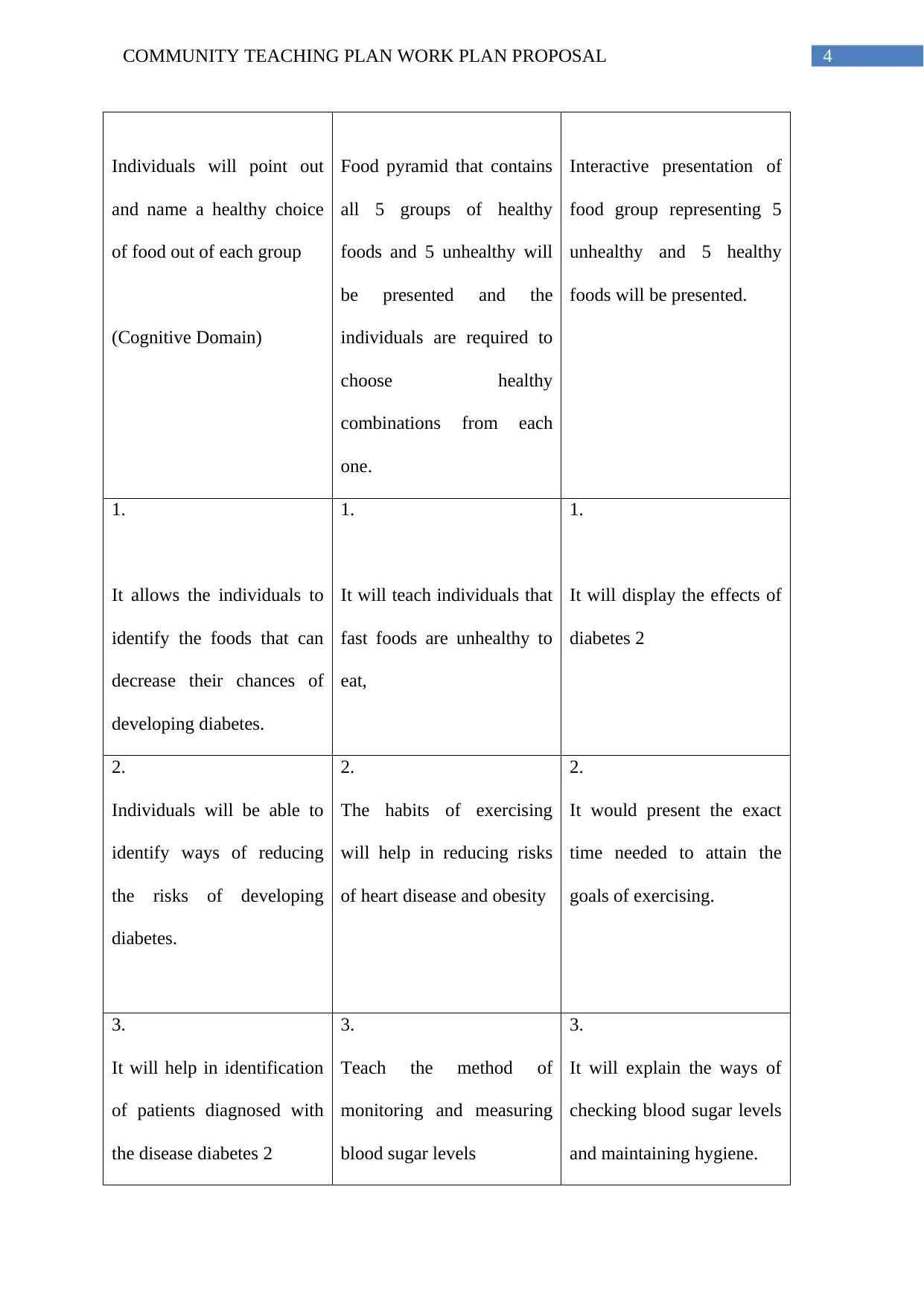
4COMMUNITY TEACHING PLAN WORK PLAN PROPOSAL
Individuals will point out
and name a healthy choice
of food out of each group
(Cognitive Domain)
Food pyramid that contains
all 5 groups of healthy
foods and 5 unhealthy will
be presented and the
individuals are required to
choose healthy
combinations from each
one.
Interactive presentation of
food group representing 5
unhealthy and 5 healthy
foods will be presented.
1.
It allows the individuals to
identify the foods that can
decrease their chances of
developing diabetes.
1.
It will teach individuals that
fast foods are unhealthy to
eat,
1.
It will display the effects of
diabetes 2
2.
Individuals will be able to
identify ways of reducing
the risks of developing
diabetes.
2.
The habits of exercising
will help in reducing risks
of heart disease and obesity
2.
It would present the exact
time needed to attain the
goals of exercising.
3.
It will help in identification
of patients diagnosed with
the disease diabetes 2
3.
Teach the method of
monitoring and measuring
blood sugar levels
3.
It will explain the ways of
checking blood sugar levels
and maintaining hygiene.
Individuals will point out
and name a healthy choice
of food out of each group
(Cognitive Domain)
Food pyramid that contains
all 5 groups of healthy
foods and 5 unhealthy will
be presented and the
individuals are required to
choose healthy
combinations from each
one.
Interactive presentation of
food group representing 5
unhealthy and 5 healthy
foods will be presented.
1.
It allows the individuals to
identify the foods that can
decrease their chances of
developing diabetes.
1.
It will teach individuals that
fast foods are unhealthy to
eat,
1.
It will display the effects of
diabetes 2
2.
Individuals will be able to
identify ways of reducing
the risks of developing
diabetes.
2.
The habits of exercising
will help in reducing risks
of heart disease and obesity
2.
It would present the exact
time needed to attain the
goals of exercising.
3.
It will help in identification
of patients diagnosed with
the disease diabetes 2
3.
Teach the method of
monitoring and measuring
blood sugar levels
3.
It will explain the ways of
checking blood sugar levels
and maintaining hygiene.
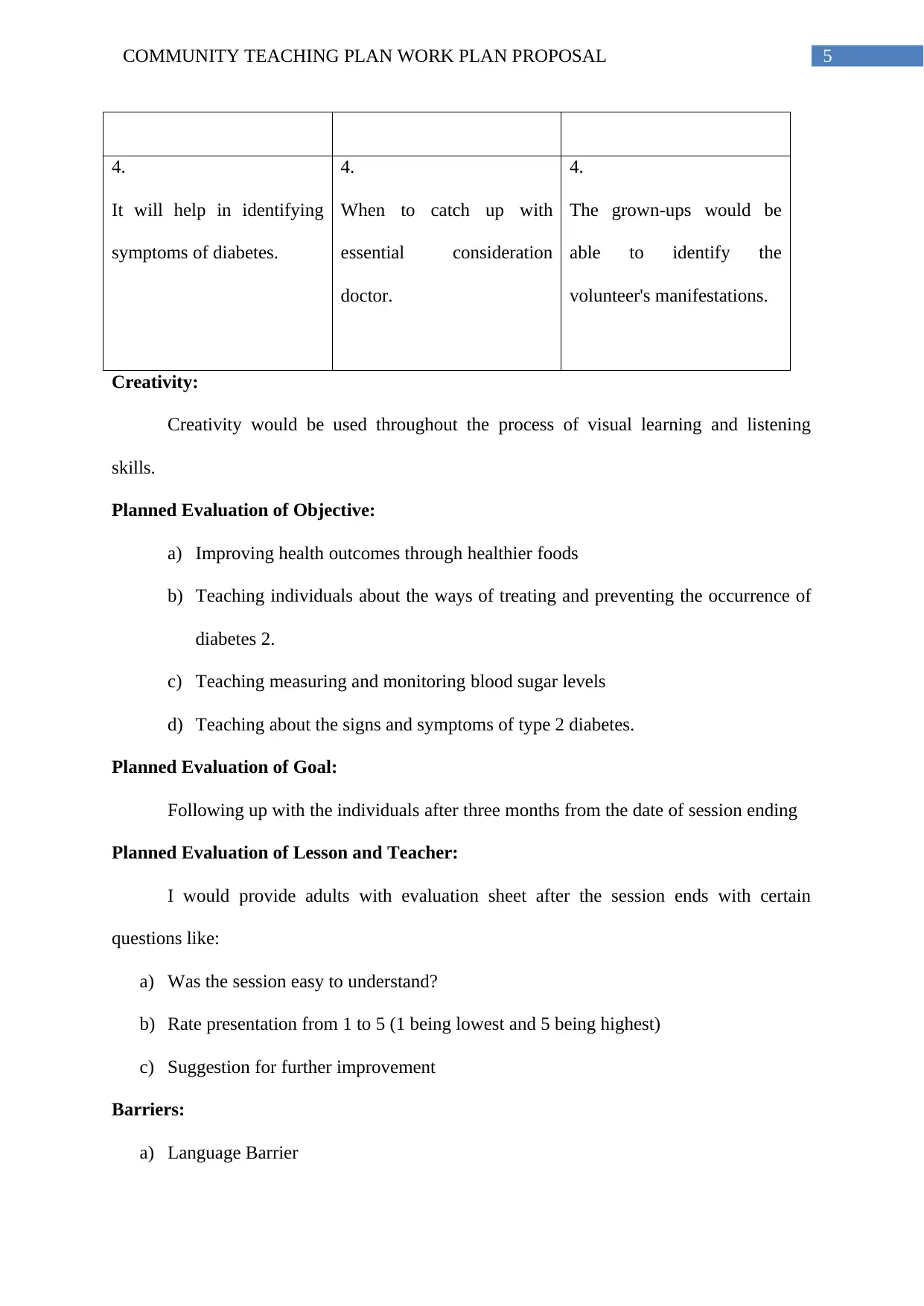
5COMMUNITY TEACHING PLAN WORK PLAN PROPOSAL
4.
It will help in identifying
symptoms of diabetes.
4.
When to catch up with
essential consideration
doctor.
4.
The grown-ups would be
able to identify the
volunteer's manifestations.
Creativity:
Creativity would be used throughout the process of visual learning and listening
skills.
Planned Evaluation of Objective:
a) Improving health outcomes through healthier foods
b) Teaching individuals about the ways of treating and preventing the occurrence of
diabetes 2.
c) Teaching measuring and monitoring blood sugar levels
d) Teaching about the signs and symptoms of type 2 diabetes.
Planned Evaluation of Goal:
Following up with the individuals after three months from the date of session ending
Planned Evaluation of Lesson and Teacher:
I would provide adults with evaluation sheet after the session ends with certain
questions like:
a) Was the session easy to understand?
b) Rate presentation from 1 to 5 (1 being lowest and 5 being highest)
c) Suggestion for further improvement
Barriers:
a) Language Barrier
4.
It will help in identifying
symptoms of diabetes.
4.
When to catch up with
essential consideration
doctor.
4.
The grown-ups would be
able to identify the
volunteer's manifestations.
Creativity:
Creativity would be used throughout the process of visual learning and listening
skills.
Planned Evaluation of Objective:
a) Improving health outcomes through healthier foods
b) Teaching individuals about the ways of treating and preventing the occurrence of
diabetes 2.
c) Teaching measuring and monitoring blood sugar levels
d) Teaching about the signs and symptoms of type 2 diabetes.
Planned Evaluation of Goal:
Following up with the individuals after three months from the date of session ending
Planned Evaluation of Lesson and Teacher:
I would provide adults with evaluation sheet after the session ends with certain
questions like:
a) Was the session easy to understand?
b) Rate presentation from 1 to 5 (1 being lowest and 5 being highest)
c) Suggestion for further improvement
Barriers:
a) Language Barrier
⊘ This is a preview!⊘
Do you want full access?
Subscribe today to unlock all pages.

Trusted by 1+ million students worldwide
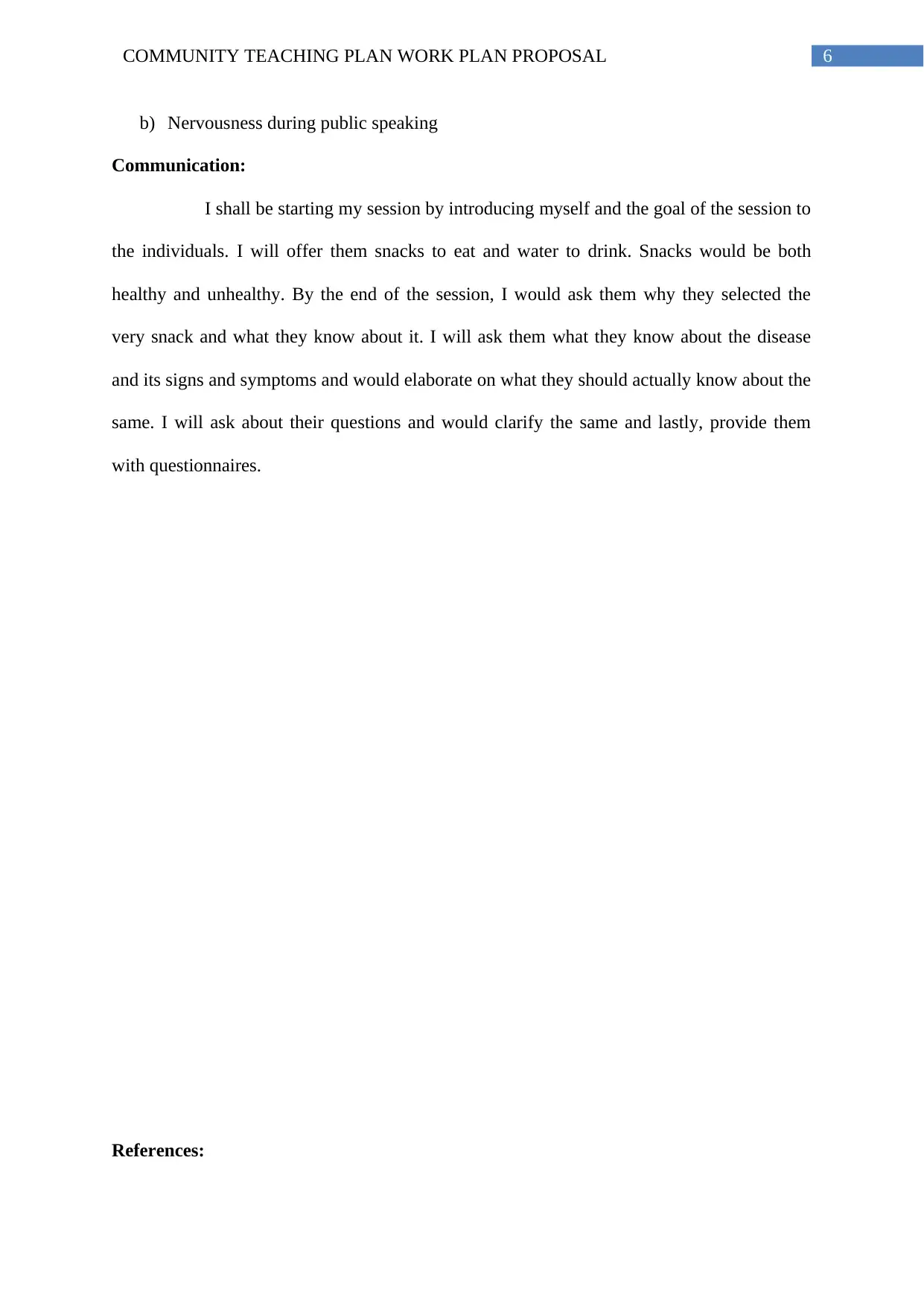
6COMMUNITY TEACHING PLAN WORK PLAN PROPOSAL
b) Nervousness during public speaking
Communication:
I shall be starting my session by introducing myself and the goal of the session to
the individuals. I will offer them snacks to eat and water to drink. Snacks would be both
healthy and unhealthy. By the end of the session, I would ask them why they selected the
very snack and what they know about it. I will ask them what they know about the disease
and its signs and symptoms and would elaborate on what they should actually know about the
same. I will ask about their questions and would clarify the same and lastly, provide them
with questionnaires.
References:
b) Nervousness during public speaking
Communication:
I shall be starting my session by introducing myself and the goal of the session to
the individuals. I will offer them snacks to eat and water to drink. Snacks would be both
healthy and unhealthy. By the end of the session, I would ask them why they selected the
very snack and what they know about it. I will ask them what they know about the disease
and its signs and symptoms and would elaborate on what they should actually know about the
same. I will ask about their questions and would clarify the same and lastly, provide them
with questionnaires.
References:
Paraphrase This Document
Need a fresh take? Get an instant paraphrase of this document with our AI Paraphraser
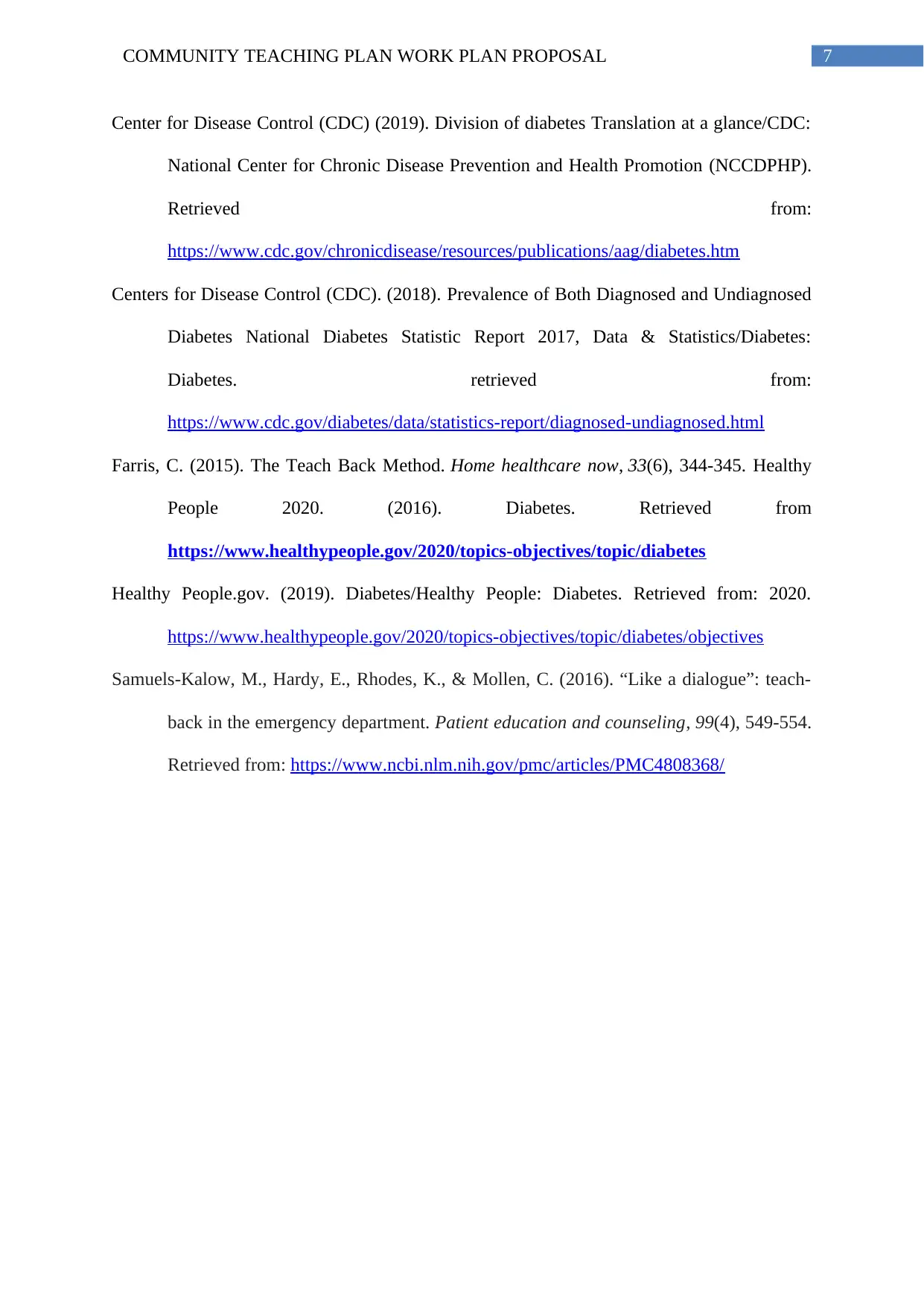
7COMMUNITY TEACHING PLAN WORK PLAN PROPOSAL
Center for Disease Control (CDC) (2019). Division of diabetes Translation at a glance/CDC:
National Center for Chronic Disease Prevention and Health Promotion (NCCDPHP).
Retrieved from:
https://www.cdc.gov/chronicdisease/resources/publications/aag/diabetes.htm
Centers for Disease Control (CDC). (2018). Prevalence of Both Diagnosed and Undiagnosed
Diabetes National Diabetes Statistic Report 2017, Data & Statistics/Diabetes:
Diabetes. retrieved from:
https://www.cdc.gov/diabetes/data/statistics-report/diagnosed-undiagnosed.html
Farris, C. (2015). The Teach Back Method. Home healthcare now, 33(6), 344-345. Healthy
People 2020. (2016). Diabetes. Retrieved from
https://www.healthypeople.gov/2020/topics-objectives/topic/diabetes
Healthy People.gov. (2019). Diabetes/Healthy People: Diabetes. Retrieved from: 2020.
https://www.healthypeople.gov/2020/topics-objectives/topic/diabetes/objectives
Samuels-Kalow, M., Hardy, E., Rhodes, K., & Mollen, C. (2016). “Like a dialogue”: teach-
back in the emergency department. Patient education and counseling, 99(4), 549-554.
Retrieved from: https://www.ncbi.nlm.nih.gov/pmc/articles/PMC4808368/
Center for Disease Control (CDC) (2019). Division of diabetes Translation at a glance/CDC:
National Center for Chronic Disease Prevention and Health Promotion (NCCDPHP).
Retrieved from:
https://www.cdc.gov/chronicdisease/resources/publications/aag/diabetes.htm
Centers for Disease Control (CDC). (2018). Prevalence of Both Diagnosed and Undiagnosed
Diabetes National Diabetes Statistic Report 2017, Data & Statistics/Diabetes:
Diabetes. retrieved from:
https://www.cdc.gov/diabetes/data/statistics-report/diagnosed-undiagnosed.html
Farris, C. (2015). The Teach Back Method. Home healthcare now, 33(6), 344-345. Healthy
People 2020. (2016). Diabetes. Retrieved from
https://www.healthypeople.gov/2020/topics-objectives/topic/diabetes
Healthy People.gov. (2019). Diabetes/Healthy People: Diabetes. Retrieved from: 2020.
https://www.healthypeople.gov/2020/topics-objectives/topic/diabetes/objectives
Samuels-Kalow, M., Hardy, E., Rhodes, K., & Mollen, C. (2016). “Like a dialogue”: teach-
back in the emergency department. Patient education and counseling, 99(4), 549-554.
Retrieved from: https://www.ncbi.nlm.nih.gov/pmc/articles/PMC4808368/
1 out of 8
Related Documents
Your All-in-One AI-Powered Toolkit for Academic Success.
+13062052269
info@desklib.com
Available 24*7 on WhatsApp / Email
![[object Object]](/_next/static/media/star-bottom.7253800d.svg)
Unlock your academic potential
Copyright © 2020–2025 A2Z Services. All Rights Reserved. Developed and managed by ZUCOL.





